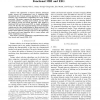Free Online Productivity Tools
i2Speak
i2Symbol
i2OCR
iTex2Img
iWeb2Print
iWeb2Shot
i2Type
iPdf2Split
iPdf2Merge
i2Bopomofo
i2Arabic
i2Style
i2Image
i2PDF
iLatex2Rtf
Sci2ools
DMIN
2007
2007
Evaluation of Feature Selection Techniques for Analysis of Functional MRI and EEG
— The application of feature selection techniques greatly reduces the computational cost of classifying highdimensional data. Feature selection algorithms of varying performance and computational complexities have been studied previously. This paper compares the performance of classical sequential methods, a floating search method, and the “globally optimal” branch and bound algorithm when applied to functional MRI and intracranial EEG to classify pathological events. We find that the sequential floating forward technique outperforms the other methodologies for these particular data. Previous works have found branch and bound to be a superior feature subset selection technique; however, in this application, the branch and bound algorithm fails to create subsets with better classification accuracy.
| Added | 29 Oct 2010 |
| Updated | 29 Oct 2010 |
| Type | Conference |
| Year | 2007 |
| Where | DMIN |
| Authors | Lauren Burrell, Otis Smart, George J. Georgoulas, Eric Marsh, George Vachtsevanos |
Comments (0)

